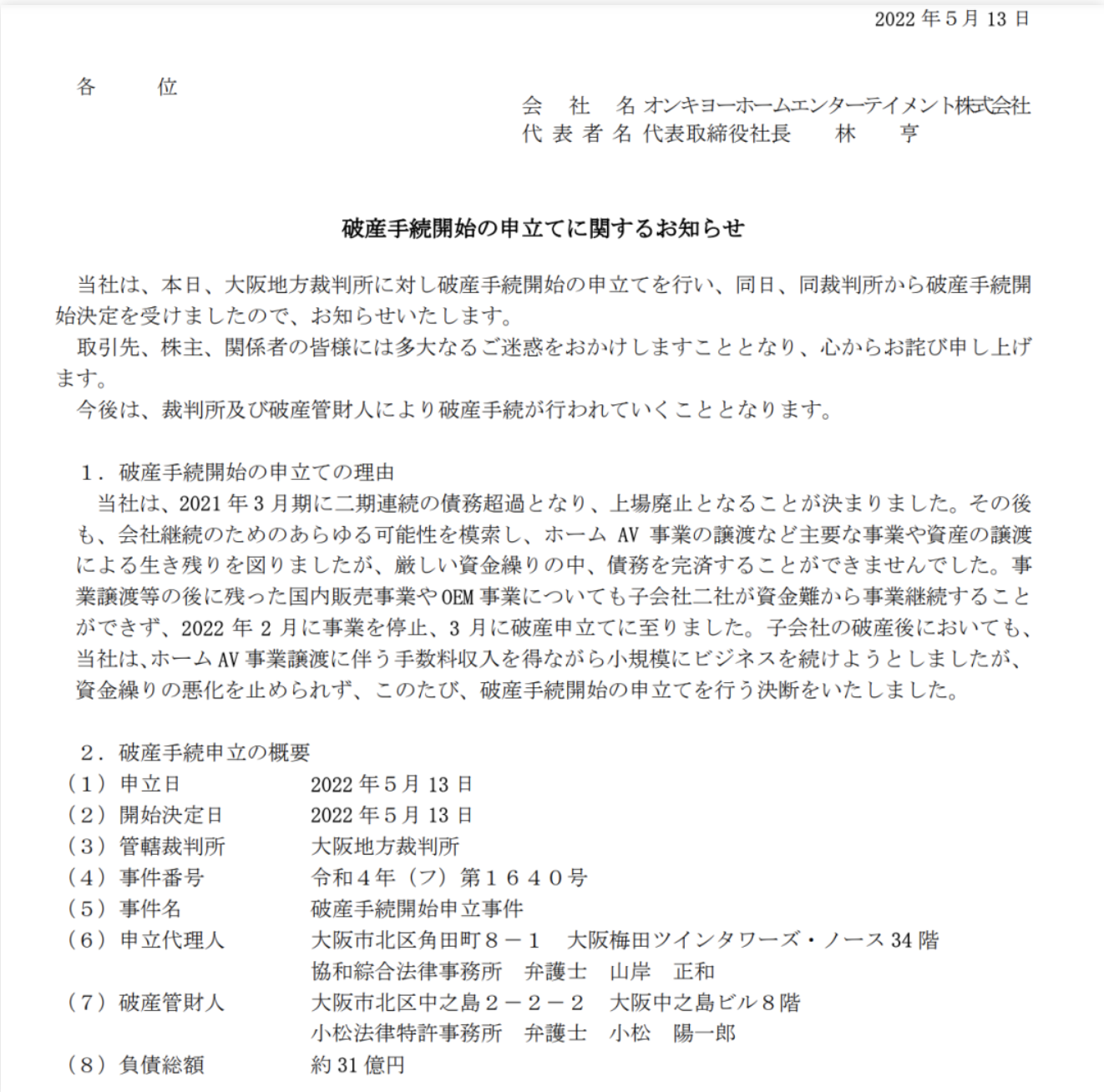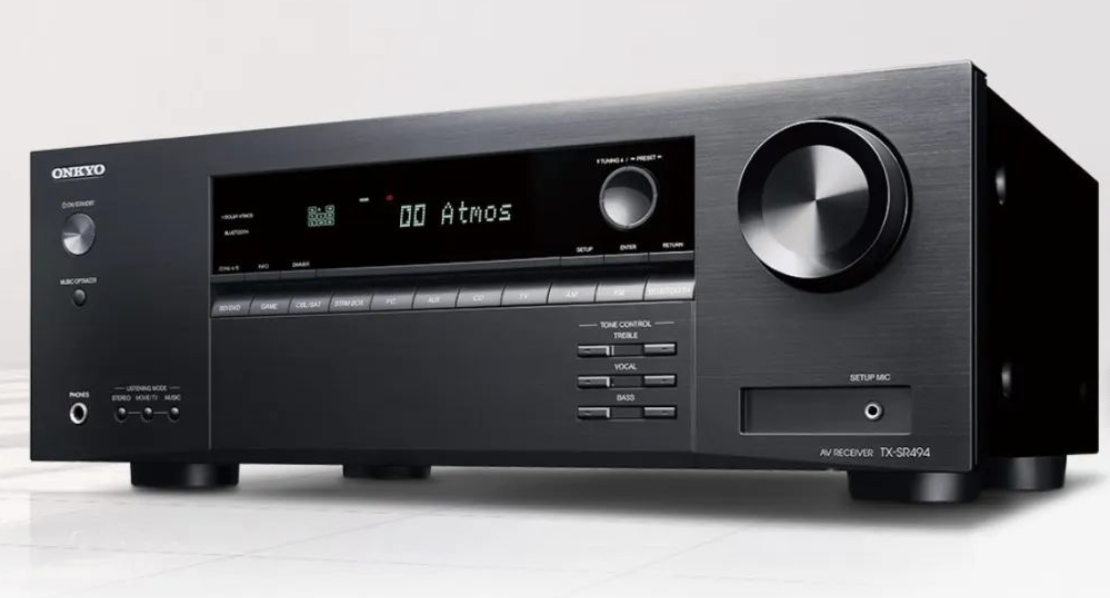On May 13, ONKYO, a long-established Japanese audio equipment manufacturer, announced on its official website that the company was filing for bankruptcy procedures with the Osaka District Court and that its total debt was approximately 3.1 billion yen.
According to the announcement, Onkyo was insolvent twice in March 2021 and decided to terminate its listing.
In order to keep the company running, Onkyo transferred its home audio and video business to Sharp and VOXX, and e-onkyo music was transferred to France's Xandrie, which operates the high-definition streaming media Qobuz. The remaining domestic sales and OEM businesses were operated by its subsidiaries Onkyo Sound and Onkyo Marketing, but they eventually stopped operations in February 2022 due to financial difficulties and filed for bankruptcy in March.
Even after the subsidiary went bankrupt, Onkyo still planned to continue operating on a small scale using the commissions from the transfer of its home audio and video business. However, it was ultimately unable to prevent the deterioration of its cash flow and filed for bankruptcy.

Image source: Onkyo official website
Before getting into this situation, Enbridge had been struggling to rebuild its operations.
As a brand with a long history of audio, amplifier and home theater, its traditional HiFi products have been severely impacted in today's mobile digital era, resulting in a decline in profits. Although the company has previously tried to sell its business, cooperate with other brands, and OEM, the financial crisis has not been alleviated.

The first failure Onkyo encountered was the cancellation of the sale of its home audio and video business. In May 2019, the company announced that it had reached an agreement with its American counterpart Sound United to sell its home audio and video business to the other party for about 8 billion yen. Onkyo President Munenori Ohama said that "we will stop the home audio and video production business, accept OEM production, and strive to achieve growth." Onkyo's sale of its ancestral business shocked the industry, but later based on Sound's intentions, the transaction was postponed. The final conditions were not reached, and the agreement was canceled on October 4, 2019. This caused Onkyo to fall into insolvency in fiscal 2019.
As the insolvency situation continued, Onkyo relied on the British Cayman Islands investment fund "Evo Fund". In July 2020, Onkyo announced a plan to issue new shares in eight batches to raise 4.6 billion yen. An executive of Onkyo said, "Even if the stock price is low, the minimum capital can be ensured." However, due to the low stock price, the plan to issue new shares was only implemented four times.
In January 2021, Onkyo held an extraordinary shareholders' meeting and decided to allocate the right to reserve new shares to EVO FUND. Onkyo said that "considering the severe financial situation and the impact of the new crown epidemic, (the fund) may not exercise the right." Although Onkyo said there are risks, it is expected to raise up to 6.2 billion yen (including the capital contribution in kind of stocks).
On June 25, 2021, Onkyo shareholders approved the proposed transaction at its ordinary shareholders meeting, and on June 28, 2021, PAC and Sharp announced the formation of a joint venture to become the acquiring entity. The total purchase price is $30.8 million, plus the assumption of certain liabilities and future commissions to Onkyo on certain product sales. PAC owns approximately 77% of the joint venture and Sharp owns approximately 23%.
If Enbridge had completed the sale by the end of June as planned, it would have solved the problem of excess debt. However, due to the impact of the COVID-19 pandemic and the filing of antitrust laws in various countries, the entire transaction was not completed until September 8.
On the one hand, due to the delay in the transaction, the fixed cost of the period could not be absorbed, resulting in debts of more than approximately 2 billion yen being transferred by the business and unable to be repaid by payment.
On the other hand, the semiconductor supply problem has not improved at all, and domestic home audio and video products have also entered a state of being unable to be delivered, and the same problem has also affected customers of the OEM business. The business of the two subsidiaries, Onkyo Sound and Onkyo Marketing, is unsustainable, and they began to file for bankruptcy on March 18, 2022.
After the subsidiary went bankrupt, in order to repay debts, Onkyo planned to use the commission fees from the transfer of the home audio and video business to operate on a small scale. However, the semiconductor supply problem has not been resolved, and the commission income has been lower than expected. Ultimately, due to difficulties in capital turnover, it decided to file for bankruptcy.
Onkyo director Hayashi Heng once said in an interview that "the mini-component audio market that has supported the company's growth in the past is close to disappearing." Onkyo has been expanding its business in the home theater field, but has failed to adapt to the ever-changing entertainment market and has failed to cultivate a new source of income. The sales of speakers, which are a source of profit, have continued to decline, and due to lack of funds, it has fallen into a vicious cycle where it cannot even maintain product manufacturing. Previously, there were also complaints from home appliance hypermarkets that "Onkyo products are not available at all."
At present, Onkyo's products include 5.1-channel and 7.2-channel home theater amplifiers, as well as HiFi stereo amplifiers, combination audio systems, etc. Among them, the home theater amplifier supports technologies such as Dolby Vision, DTS:X, Dolby Atmos, and has AccuEQ room acoustics calibration function.
About Onkyo ONKYO was founded in 1946. Its name means "sound" in Japanese. The original purpose of ONKYO was to reinterpret music and movies in the purest way possible. The earliest story began in 1905, when a little boy named Konosuke Matsushita got a part-time job at the Goshiro Bicycle Company. Matsushita and his childhood friend Takeshi Goshiro (founder of Onkyo) worked very hard there. They saved the money that Takeshi Goshiro's father asked them to help buy cigarettes, and earned the difference by purchasing in bulk, and thus made their first fortune. Later, Konosuke Matsushita established the now world-famous Panasonic Corporation, and Mr. Goshiro became one of his company's top engineers. After World War II, Panasonic decided to split its audio department. In 1946, Mr. Goshiro seized this opportunity and established Onkyo Co., Ltd. Osaka Electric. In the following decades of development, Onkyo has always been firm in applying the most advanced digital technology to audio and video products. Japan's Onkyo Corporation owns many well-known brands such as Onkyo and Integra.
Previous article:BOE President Dr. Gao Wenbao delivered a speech: SID's 60th anniversary: Three major innovative concepts lead the sustainable development of the industry
Next article:BOE and SAIC Feifan Auto achieve new breakthrough in flexible OLED in-vehicle applications
- Popular Resources
- Popular amplifiers
- Enjoy big-screen gaming anytime, anywhere: Making portable 4K UHD 240Hz gaming projector a reality
- AMD surpasses Intel: CPU shipments surge in Q3 this year
- Exynos is losing ground, Samsung plans to use Qualcomm chips in home appliances
- Intel and 50 partners unveiled a full range of 30 notebook and desktop AI PCs equipped with Intel Core Ultra (2nd Generation)
- Innovation leads the new trend of mobile refrigeration GMCC will present new products at 2024 CIAAR
- Lenovo and NVIDIA expand collaboration to jointly launch new liquid-cooled AI servers
- Ceiling fan solution based on XMC1302
- Gartner: Global AI PC shipments are expected to account for 43% of total PC shipments in 2025
- Intel releases its first AI PC desktop processor, the Core Ultra 200S
- LED chemical incompatibility test to see which chemicals LEDs can be used with
- Application of ARM9 hardware coprocessor on WinCE embedded motherboard
- What are the key points for selecting rotor flowmeter?
- LM317 high power charger circuit
- A brief analysis of Embest's application and development of embedded medical devices
- Single-phase RC protection circuit
- stm32 PVD programmable voltage monitor
- Introduction and measurement of edge trigger and level trigger of 51 single chip microcomputer
- Improved design of Linux system software shell protection technology
- What to do if the ABB robot protection device stops
- Detailed explanation of intelligent car body perception system
- How to solve the problem that the servo drive is not enabled
- Why does the servo drive not power on?
- What point should I connect to when the servo is turned on?
- How to turn on the internal enable of Panasonic servo drive?
- What is the rigidity setting of Panasonic servo drive?
- How to change the inertia ratio of Panasonic servo drive
- What is the inertia ratio of the servo motor?
- Is it better for the motor to have a large or small moment of inertia?
- What is the difference between low inertia and high inertia of servo motors?
- SimpleLink MCU code migration guide: CC1310 from VQFN48 (7×7) to VQFN32 (5×5) code migration process reference
- Welcome the new moderator of the "201420208012" eSports
- What is the difference between a servo motor and a brushless DC motor?
- [Raspberry Pi Pico Review] ADC External Benchmark vs. Onboard Benchmark
- Do DC powered devices have common mode interference?
- Allegro photo-painting problem
- The PCIE communication problem that has troubled me for three days - please help!
- Watch the live broadcast and win an oscilloscope | Today at 2 pm RIGOL live broadcast [Oscilloscope, programmable DC power supply, spectrum analyzer application...
- Typical Vacuum Cleaner/Robot Sweeper BMS Topology
- TI's crystal-free SimpleLink wireless MCU helps you easily achieve crystal-free

 LT1102AMH#PBF
LT1102AMH#PBF











 京公网安备 11010802033920号
京公网安备 11010802033920号